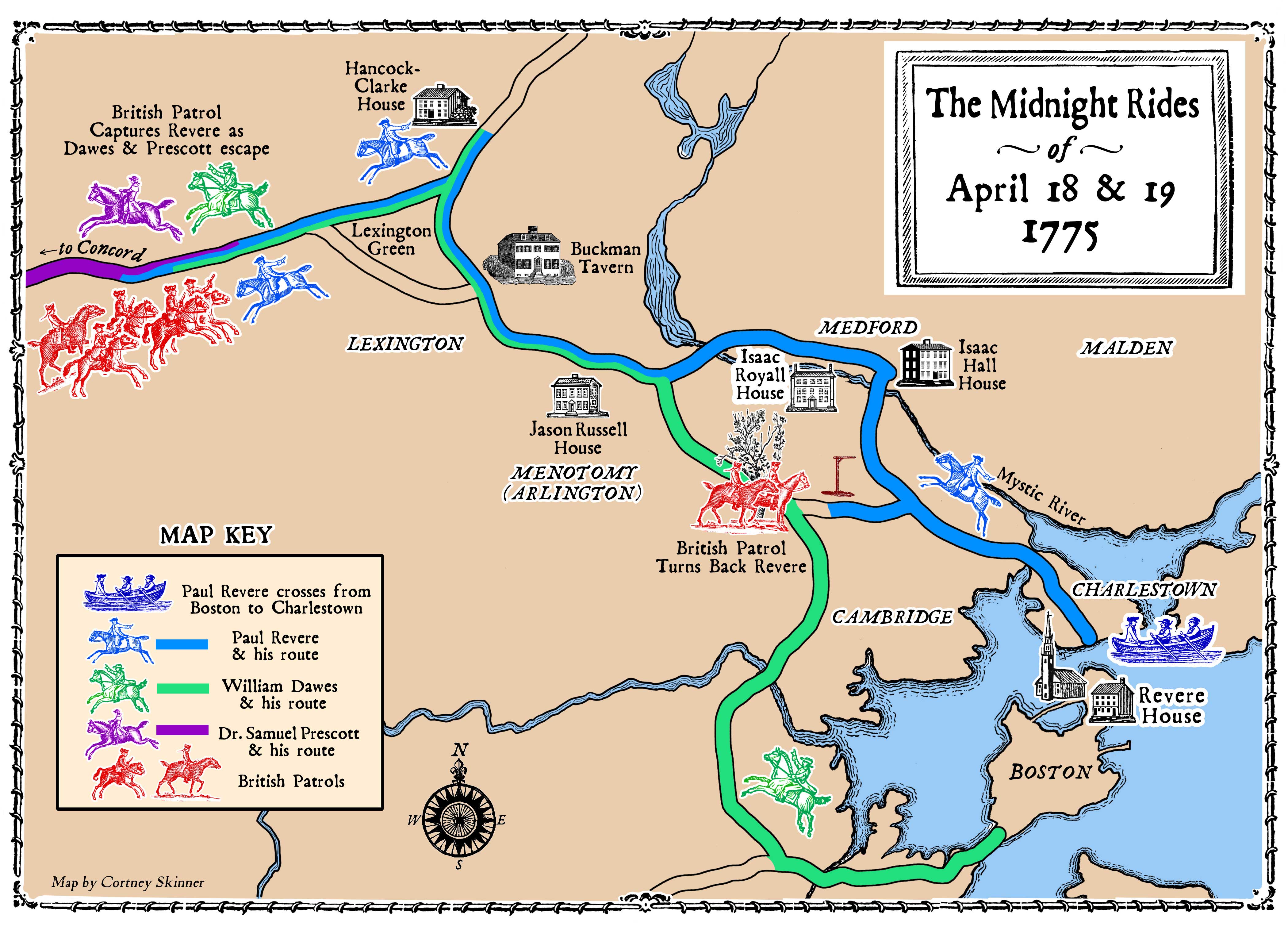Interactive Map:
The Midnight Rides of April 18 & 19, 1775
The Midnight Rides of April 18-19, 1775
Get Started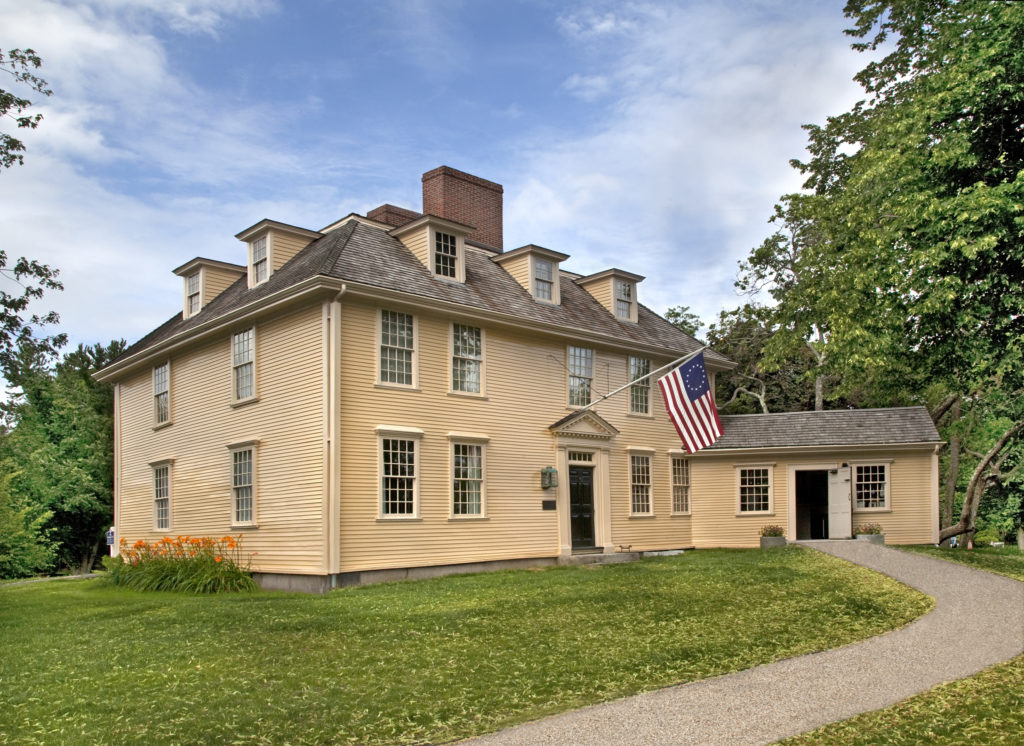
Buckman Tavern, Lexington MA — Buckman Tavern; Courtesy of Lexington Historical Society, Lexington MA
“Mr. Lowell and my self went towards the Tavern, when we met a Man on a full gallop, who told us the Troops were coming up the Rocks. Mr. Lowell asked me to go to the Tavern with him, to [a] git a Trunk of papers belonging to Mr. Hancock. We went up Chamber; and while we were giting the Trunk, we saw the British very near, upon a full March. We hurried towards Mr. Clark’s House. In our way, we passed through the Militia. There were about 50.”
Revere's last known action for the day in moving Hancock's trunk is one of the great mysteries of April 18/19. What was in the trunk? Was it ever recovered? We do not know the answers to these questions, but it certainly has allowed for great speculation!
Learn More...FinishedFollow the Midnight Rides of April 18-19, 1775.
Get Started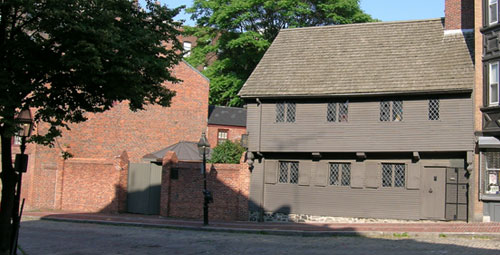
The Paul Revere House — Paul Revere Memorial Association
Paul Revere did indeed stop briefly as his house on the night of April 18, 1775 before setting out on his famous ride. Revere had only owned the house for 5 years at that stage, as the family had purchased the home just two weeks before the Boston Massacre in 1770.
Next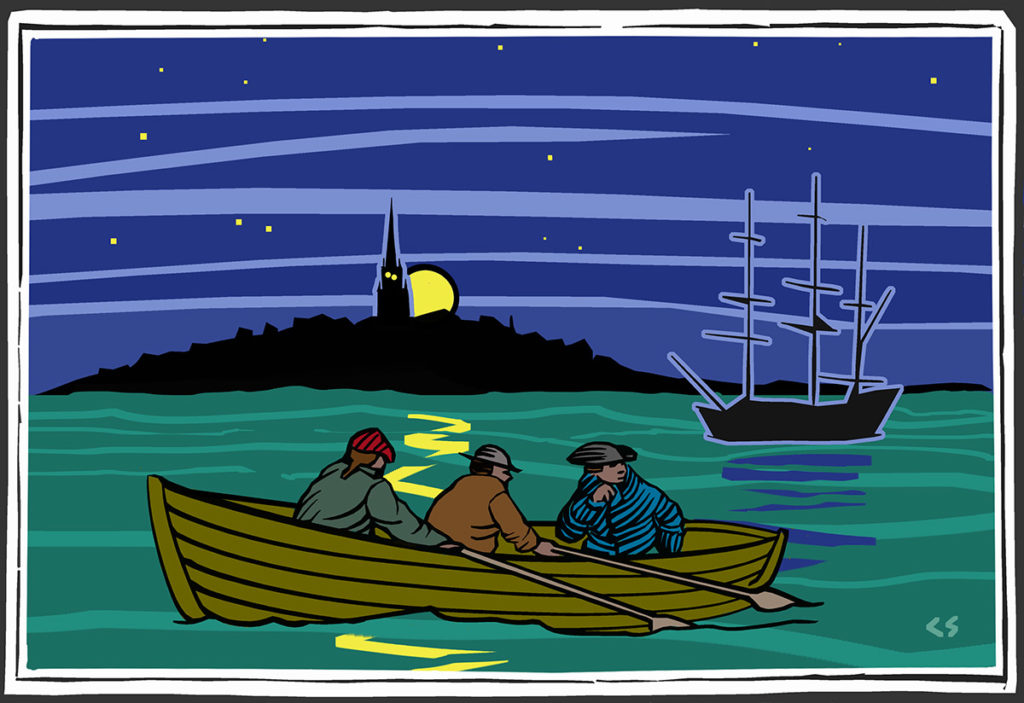
Paul Revere crosses the Charles — Artwork by Cortney Skinner
Revere’s two friends who rowed him to Charlestown were Joshua Bentley, a boat builder and Thomas Richardson, a shipwright. They would have been perfect for the job: local men who were expert rowers and familiar enough with the shoreline and harbor to attempt this mission in the dark of the night. Revere had stashed his boat at the harbor ahead of time so the trio had easy access and avoided detection from the HMS Somerset on their route.
Next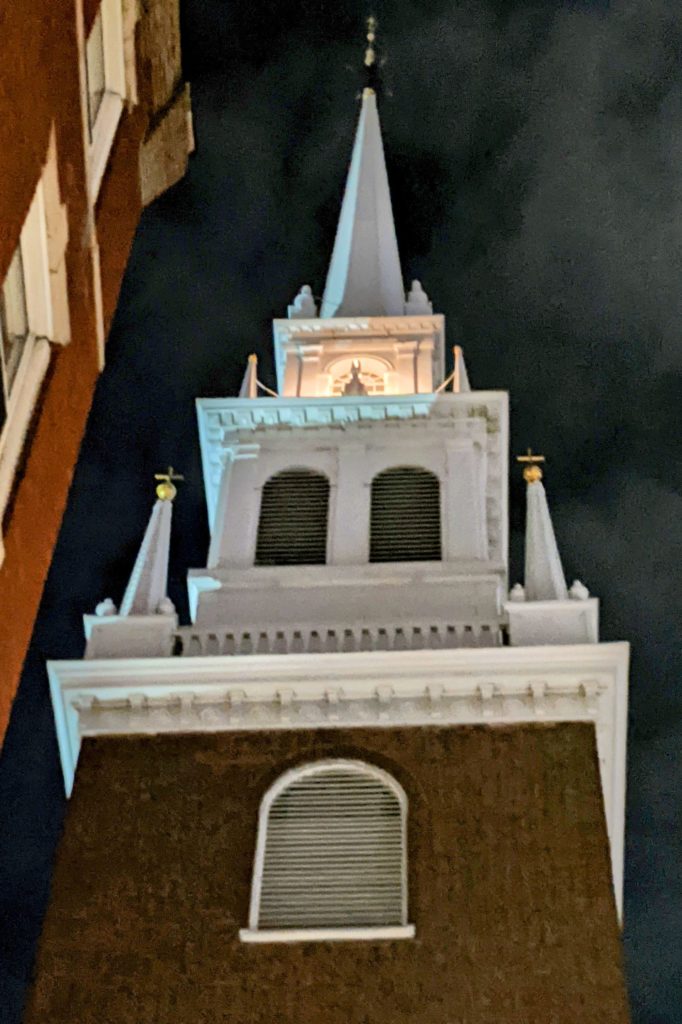
2 lights shine from the steeple of the Old North Church — Courtesy of The Old North Church & Historic Site, Boston MA
Paul Revere and his colleagues had decided that a signal sytem from Boston was needed after a prior scouting mission to Lexington. With Old North Church's steeple being visible in Charlestown, it was an obvious to choice to convey via lanterns if the British soldiers were taking the land route out of Boston Neck or the water route across the Charles to being their march.
Learn More...Next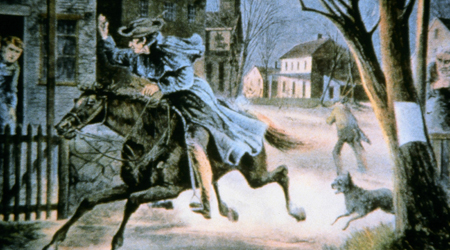
Vintage Post Card of Paul Revere’s Ride — Courtesy of Paul Revere Memorial Association
We know Paul Revere did not own a horse at the time of his ride, but had built himself up as a trusted express rider for the Sons of Liberty through missions in previous years. He must have been an accomplished horsemen to undertake lengthy trips on short notice to New York and Philadelphia.
Next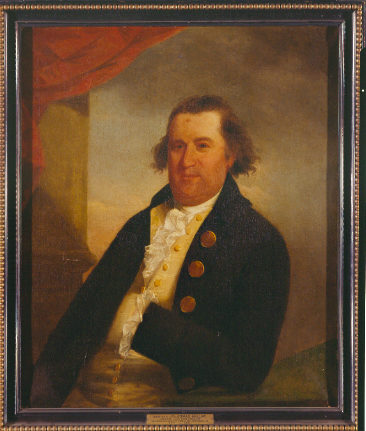
William Dawes — Courtesy of Cary Memorial Library, Lexington MA
Revere was far from the only rider on the night of April 18, and not the only one from Boston. Fellow Son of Liberty William Dawes was tasked with taking the physically longer but logistically easier land route out of Boston neck to reach Lexington, compared to Revere needing to be rowed across the Charles. Dawes completed his ride about a half hour after Revere, but the function of each one taking a different route shows the fail-safes built in by the Patriot leadership.
Next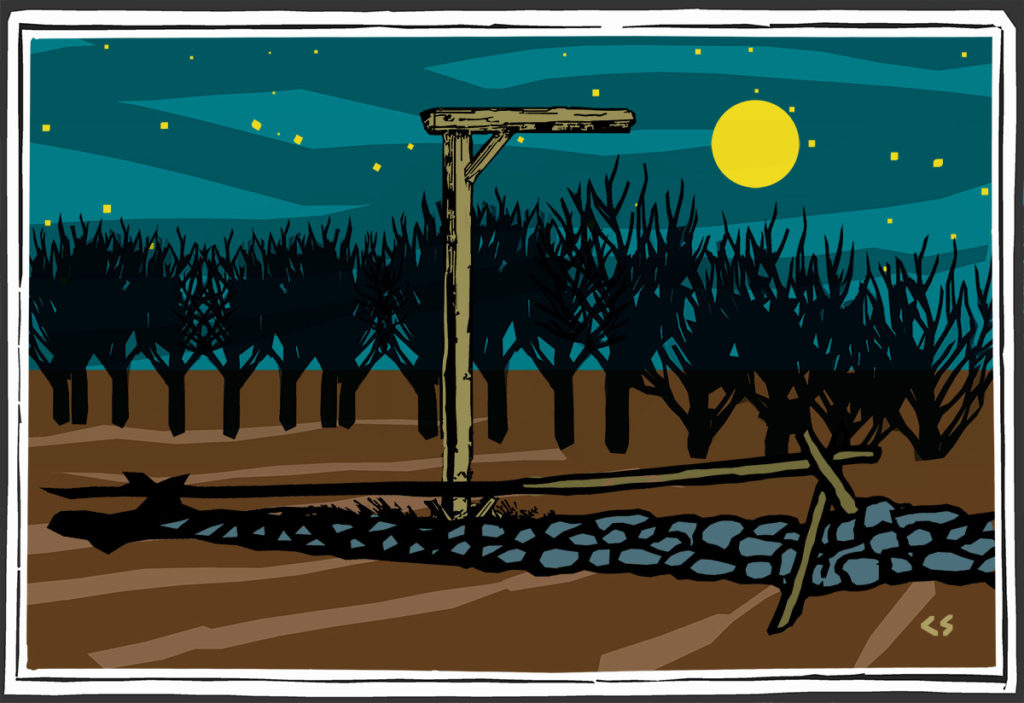
Gallows outside of Charlestown — Artwork by Cortney Skinner
The trial of Mark, an enslaved man who was charged killed his enslaver John Codman, was a major case in 1755 Boston. After his hanging, Mark's body was hung in a gibbet as a grisly reminder of his crime and as a macabre deterrent for other enslaved individuals to take such actions.
Learn More...Next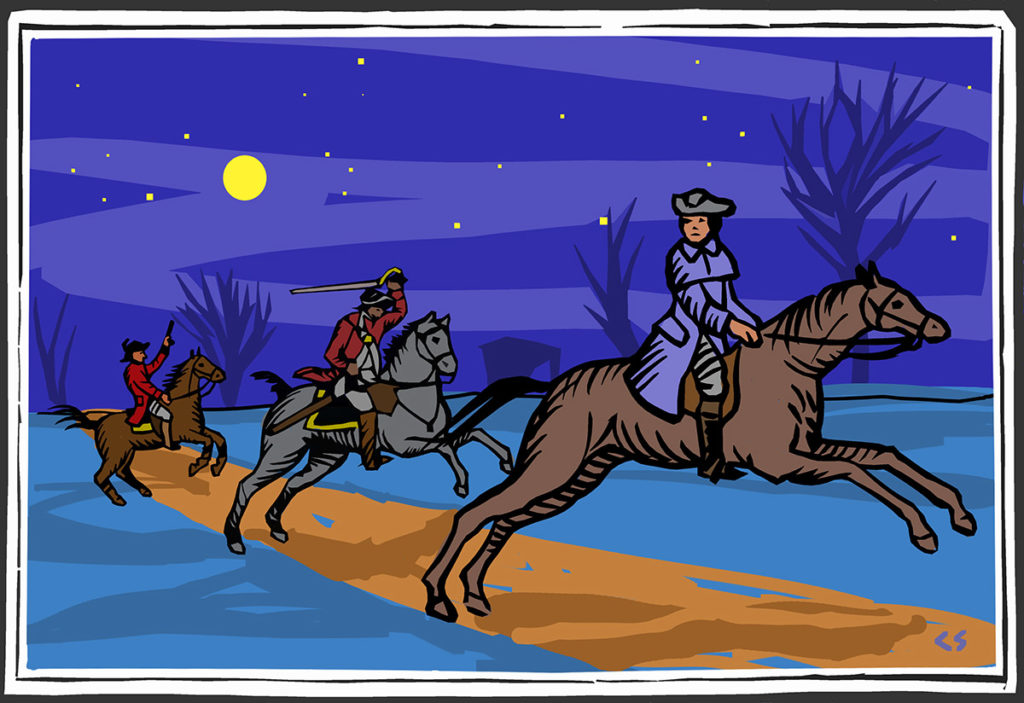
Revere Escapes capture — Artwork by Cortney Skinner
Revere's quick thinking helped him elude his would-be captors early in his Ride. Patrols were out to stop Revere and other riders from spreading the news of the evening like wildfire through the countryside.
Next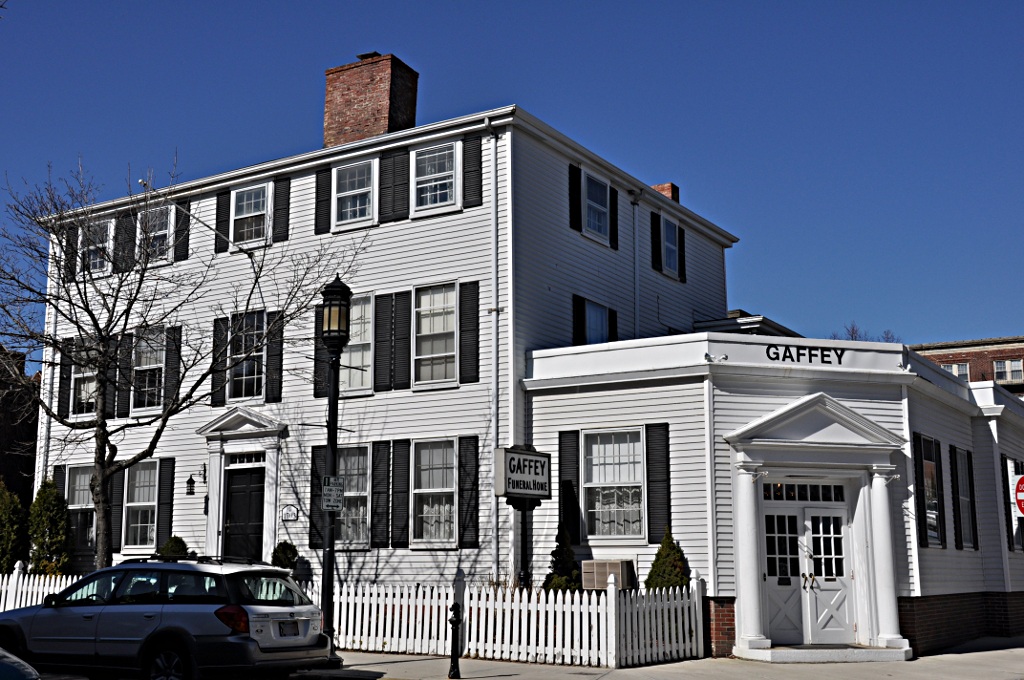
Isaac Hall House, Medford MA — Courtesy of Wikimedia Commons
Paul Revere met briefly with Isaac Hall, the Captain of the Medford Minute Men. The systems in place for the Sons of Liberty and Minute Men allowed messages to be conveyed quickly over large geographical areas. Hall's house still stands in Medford today.
Next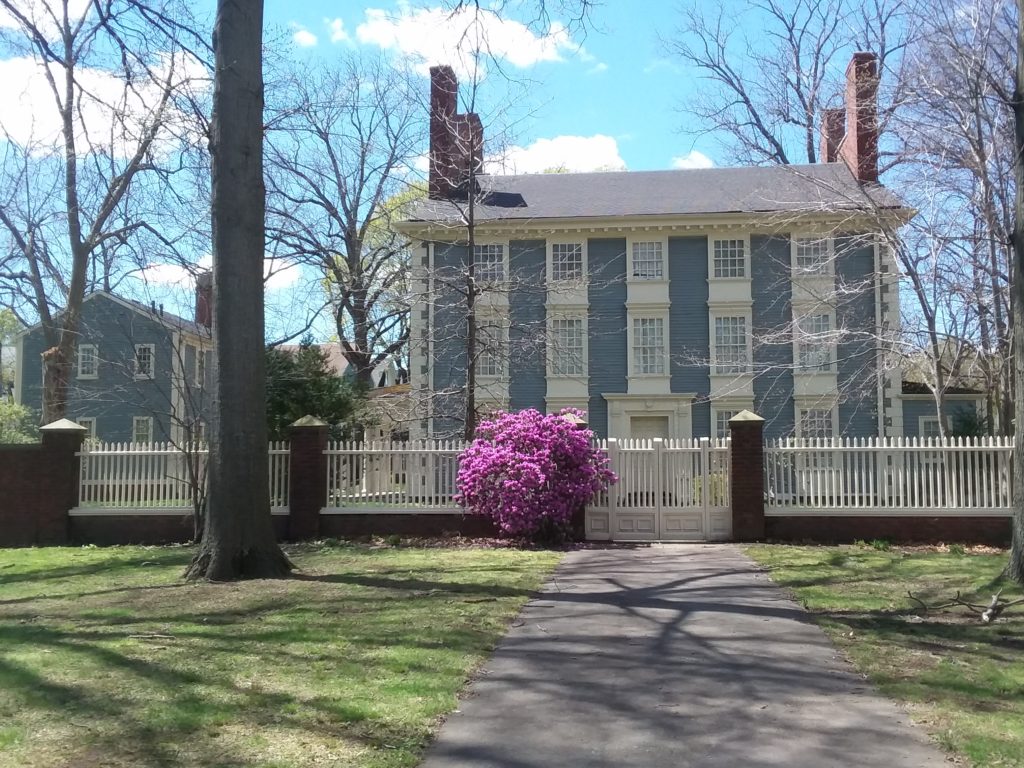
Royall House and Slave Quarters — Courtesy of Royall House & Slave Quarters, Medford MA
Paul Revere would have passed Loyalist homes on his route, like the Royall House. The Royalls were the largest slaveholding family in Massachusetts, and Isaac Royall, Jr. ultimately fled to England with many of his fellow Tories.
Learn More...Next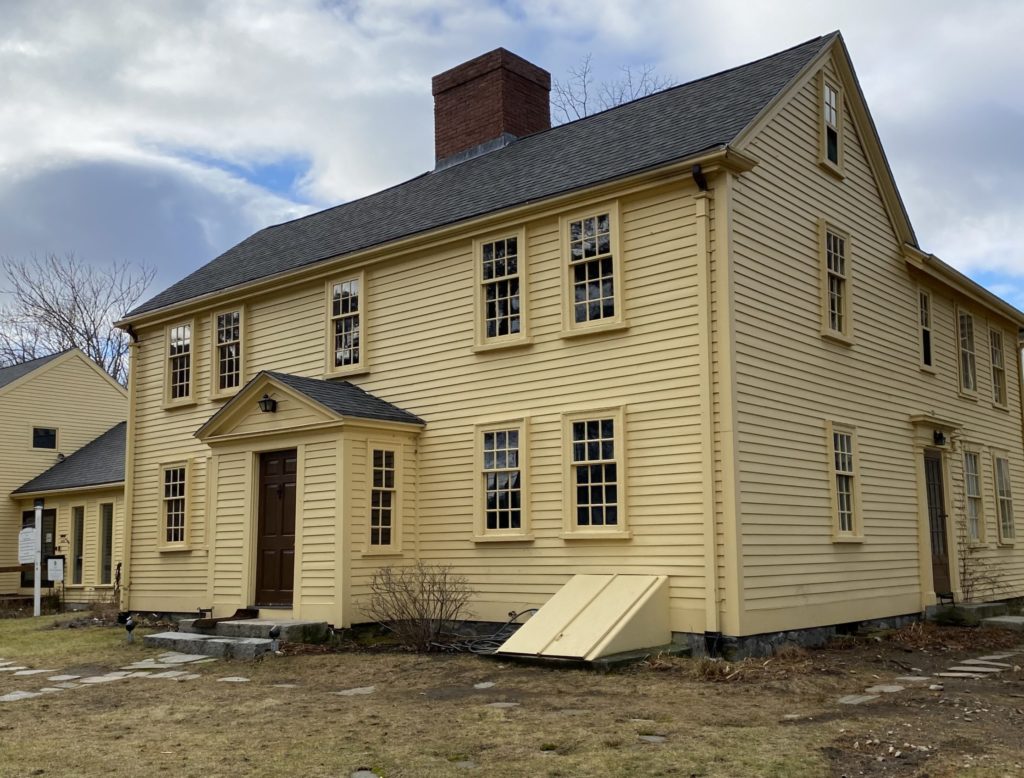
Jason Russell House, Arlington MA —
Revere passed and may have alarmed those living at the Jason Russell House. Less than twenty hours later the house would become one of the bloodiest battle locations upon the British retreat back to Boston.
Next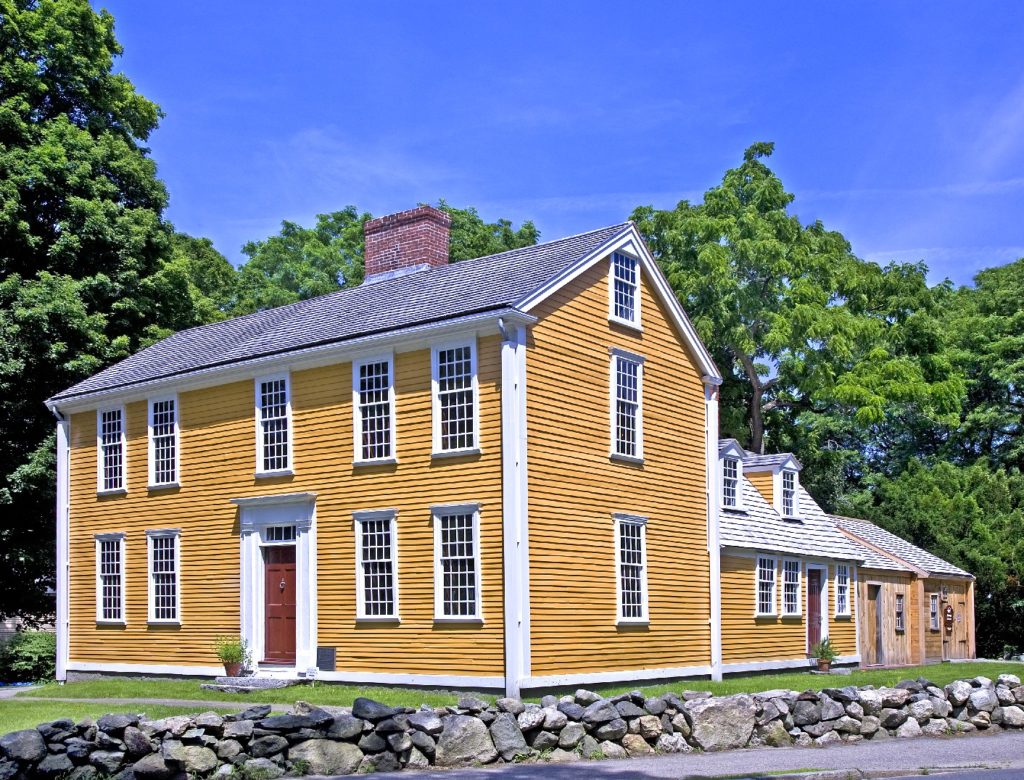
Hancock – Clarke House, Lexington MA — Courtesy of Lexington Historical Society, Lexington MA
Revere had two encounters with Hancock, Adams, and their party at the Hancock-Clarke House. According to later sources, the sentry told Revere to be quiet upon his initial arrival. Revere retorted by stating "Noise! You'll have noise enough before long! The regulars are coming out!" Revere's urgency did not spur action, however, as Hancock and Adams were still at the house around 4 AM when Revere returned from his brief detainment. The men and their party did leave for Woburn at this stage.
Learn More...NextRevere and Dawes had officially completed their missions to alert Hancock and Adams, so both did finish their intended rides. The decision to push on towards Concord was an additional step they decided to risk.
Next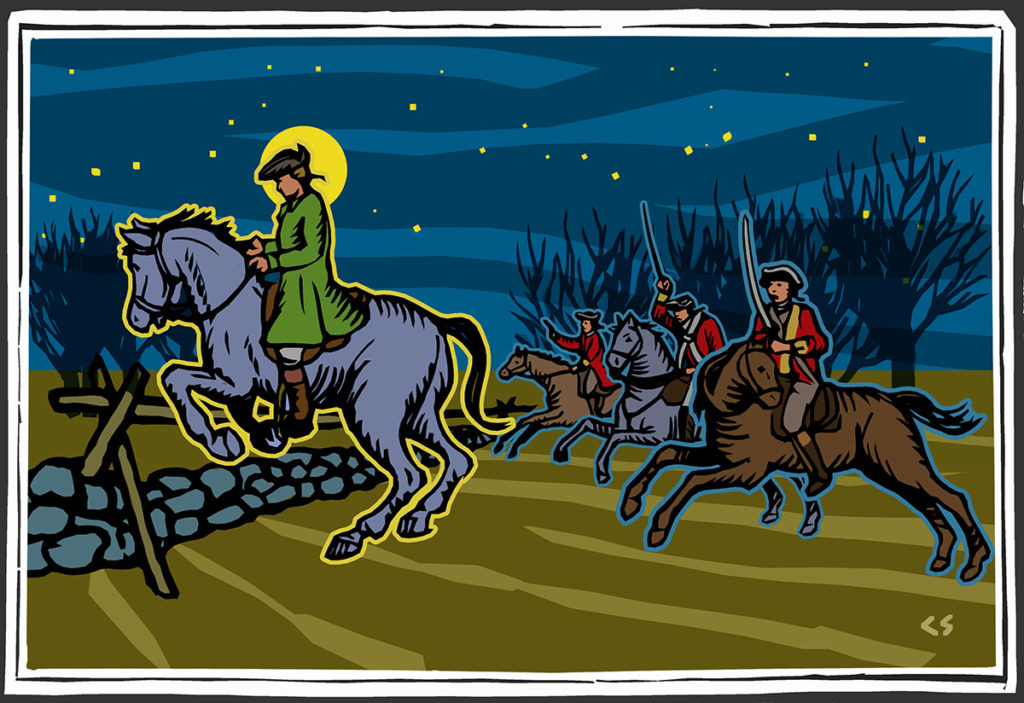
Samuel Prescott Escapes — Artwork by Cortney Skinner
There is not a great deal known about Dr. Samuel Prescott beyond his actions on the morning of April 19, 1775. He was returning home after a visit to his girlfriend's house, and Revere indicated that he and Dawes immediately trusted Prescott's credentials and decided to loop him into the ride to Concord as the Doctor knew the terrain best of the three.
Next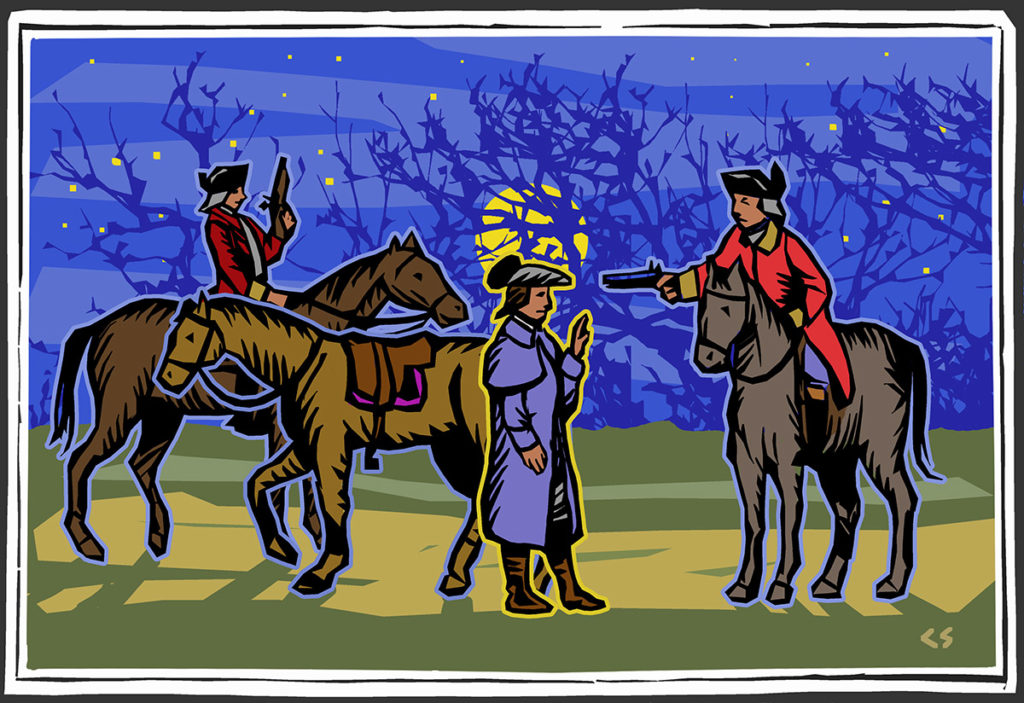
Revere captured by a British patrol — Artwork by Cortney Skinner
“…in an instant I saw four of them, who rode up to me, with their pistols in their hands, said G-d d-n you stop. If you go an Inch further, you are a dead Man…we attempted to git thro them, but they kept before us, and swore if we did not turn in to that pasture, they would blow our brains out . . . .One of them, who appeared to have the command, and much of a Gentleman, Asked me where I came from; I told him, he asked me what time I left it; I told him, he seemed surprised, said Sir may I crave your name, I answered my name is Revere, what said he Paul Revere; I answered yes; the others abused much; but he told me not to be afraid, no one should hurt me . . . I told him they would miss their aim”
While Revere was threatened at gunpoint and detained for a few hours, he was eventually able to talk his way out of the situation with his captors. Revere was eventually released, though they took his horse and he had to walk the final stretch back to Lexington Green. Dawes evaded capture, as did Prescott, but the Doctor was the only one of the three to make it all the way to Concord.
Learn More...Next
Buckman Tavern, Lexington MA — Buckman Tavern; Courtesy of Lexington Historical Society, Lexington MA
“Mr. Lowell and my self went towards the Tavern, when we met a Man on a full gallop, who told us the Troops were coming up the Rocks. Mr. Lowell asked me to go to the Tavern with him, to [a] git a Trunk of papers belonging to Mr. Hancock. We went up Chamber; and while we were giting the Trunk, we saw the British very near, upon a full March. We hurried towards Mr. Clark’s House. In our way, we passed through the Militia. There were about 50.”
Revere's last known action for the day in moving Hancock's trunk is one of the great mysteries of April 18/19. What was in the trunk? Was it ever recovered? We do not know the answers to these questions, but it certainly has allowed for great speculation!
Learn More...FinishedFollow the Midnight Rides of April 18-19, 1775.
Get Started
The Paul Revere House — Paul Revere Memorial Association
Paul Revere did indeed stop briefly as his house on the night of April 18, 1775 before setting out on his famous ride. Revere had only owned the house for 5 years at that stage, as the family had purchased the home just two weeks before the Boston Massacre in 1770.
Next
Paul Revere crosses the Charles — Artwork by Cortney Skinner
Revere’s two friends who rowed him to Charlestown were Joshua Bentley, a boat builder and Thomas Richardson, a shipwright. They would have been perfect for the job: local men who were expert rowers and familiar enough with the shoreline and harbor to attempt this mission in the dark of the night. Revere had stashed his boat at the harbor ahead of time so the trio had easy access and avoided detection from the HMS Somerset on their route.
Next
2 lights shine from the steeple of the Old North Church — Courtesy of The Old North Church & Historic Site, Boston MA
Paul Revere and his colleagues had decided that a signal sytem from Boston was needed after a prior scouting mission to Lexington. With Old North Church's steeple being visible in Charlestown, it was an obvious to choice to convey via lanterns if the British soldiers were taking the land route out of Boston Neck or the water route across the Charles to being their march.
Learn More...Next
Vintage Post Card of Paul Revere’s Ride — Courtesy of Paul Revere Memorial Association
We know Paul Revere did not own a horse at the time of his ride, but had built himself up as a trusted express rider for the Sons of Liberty through missions in previous years. He must have been an accomplished horsemen to undertake lengthy trips on short notice to New York and Philadelphia.
Next
William Dawes — Courtesy of Cary Memorial Library, Lexington MA
Revere was far from the only rider on the night of April 18, and not the only one from Boston. Fellow Son of Liberty William Dawes was tasked with taking the physically longer but logistically easier land route out of Boston neck to reach Lexington, compared to Revere needing to be rowed across the Charles. Dawes completed his ride about a half hour after Revere, but the function of each one taking a different route shows the fail-safes built in by the Patriot leadership.
Next
Gallows outside of Charlestown — Artwork by Cortney Skinner
The trial of Mark, an enslaved man who was charged killed his enslaver John Codman, was a major case in 1755 Boston. After his hanging, Mark's body was hung in a gibbet as a grisly reminder of his crime and as a macabre deterrent for other enslaved individuals to take such actions.
Learn More...Next
Revere Escapes capture — Artwork by Cortney Skinner
Revere's quick thinking helped him elude his would-be captors early in his Ride. Patrols were out to stop Revere and other riders from spreading the news of the evening like wildfire through the countryside.
Next
Isaac Hall House, Medford MA — Courtesy of Wikimedia Commons
Paul Revere met briefly with Isaac Hall, the Captain of the Medford Minute Men. The systems in place for the Sons of Liberty and Minute Men allowed messages to be conveyed quickly over large geographical areas. Hall's house still stands in Medford today.
Next
Royall House and Slave Quarters — Courtesy of Royall House & Slave Quarters, Medford MA
Paul Revere would have passed Loyalist homes on his route, like the Royall House. The Royalls were the largest slaveholding family in Massachusetts, and Isaac Royall, Jr. ultimately fled to England with many of his fellow Tories.
Learn More...Next
Jason Russell House, Arlington MA —
Revere passed and may have alarmed those living at the Jason Russell House. Less than twenty hours later the house would become one of the bloodiest battle locations upon the British retreat back to Boston.
Next
Hancock – Clarke House, Lexington MA — Courtesy of Lexington Historical Society, Lexington MA
Revere had two encounters with Hancock, Adams, and their party at the Hancock-Clarke House. According to later sources, the sentry told Revere to be quiet upon his initial arrival. Revere retorted by stating "Noise! You'll have noise enough before long! The regulars are coming out!" Revere's urgency did not spur action, however, as Hancock and Adams were still at the house around 4 AM when Revere returned from his brief detainment. The men and their party did leave for Woburn at this stage.
Learn More...NextRevere and Dawes had officially completed their missions to alert Hancock and Adams, so both did finish their intended rides. The decision to push on towards Concord was an additional step they decided to risk.
Next
Samuel Prescott Escapes — Artwork by Cortney Skinner
There is not a great deal known about Dr. Samuel Prescott beyond his actions on the morning of April 19, 1775. He was returning home after a visit to his girlfriend's house, and Revere indicated that he and Dawes immediately trusted Prescott's credentials and decided to loop him into the ride to Concord as the Doctor knew the terrain best of the three.
Next
Revere captured by a British patrol — Artwork by Cortney Skinner
“…in an instant I saw four of them, who rode up to me, with their pistols in their hands, said G-d d-n you stop. If you go an Inch further, you are a dead Man…we attempted to git thro them, but they kept before us, and swore if we did not turn in to that pasture, they would blow our brains out . . . .One of them, who appeared to have the command, and much of a Gentleman, Asked me where I came from; I told him, he asked me what time I left it; I told him, he seemed surprised, said Sir may I crave your name, I answered my name is Revere, what said he Paul Revere; I answered yes; the others abused much; but he told me not to be afraid, no one should hurt me . . . I told him they would miss their aim”
While Revere was threatened at gunpoint and detained for a few hours, he was eventually able to talk his way out of the situation with his captors. Revere was eventually released, though they took his horse and he had to walk the final stretch back to Lexington Green. Dawes evaded capture, as did Prescott, but the Doctor was the only one of the three to make it all the way to Concord.
Learn More...Next
Buckman Tavern, Lexington MA — Buckman Tavern; Courtesy of Lexington Historical Society, Lexington MA
“Mr. Lowell and my self went towards the Tavern, when we met a Man on a full gallop, who told us the Troops were coming up the Rocks. Mr. Lowell asked me to go to the Tavern with him, to [a] git a Trunk of papers belonging to Mr. Hancock. We went up Chamber; and while we were giting the Trunk, we saw the British very near, upon a full March. We hurried towards Mr. Clark’s House. In our way, we passed through the Militia. There were about 50.”
Revere's last known action for the day in moving Hancock's trunk is one of the great mysteries of April 18/19. What was in the trunk? Was it ever recovered? We do not know the answers to these questions, but it certainly has allowed for great speculation!
Learn More...FinishedTo learn more about Paul Revere’s Ride, check out our page “The Real Story of Paul Revere’s Ride.” After that, you can compare the real Midnight Rides to the Longfellow poem that made Paul Revere famous and get answers to our most asked questions! If you’re feeling adventurous, you can also go on a drive to recreate Paul Revere’s ride. To incorporate Primary Sources, check out Paul Revere’s account of the Ride in his own handwriting, courtesy of the Massachusetts Historical Society.
This interactive map was funded in part with a grant from the Massachusetts Foundation for the Humanities. Special thanks to historical illustrator Cortney Skinner for creating the map and illustrations, Eric Hanson-Plass of the National Parks of Boston for his work installing Leaflet and the necessary code, and Scot Castellani for website technical support.

